We did a spelling mistake in giving the link to the Circus of Insect.
Their correct site is:
www.insectcircus.co.uk
Thursday, October 26, 2006
Wednesday, October 25, 2006
Insect Circus
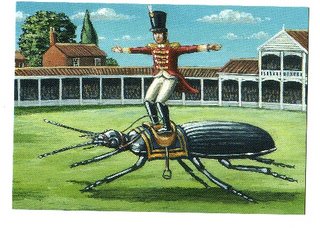
In times of revitalization of human circuses, a field so often infested by artistic parasithism, how welcome is a show done completely by honest and genuine parasites, encouraging a flourishing future for the always ambitious art of the arena.
We recently discovered “Circus of Insects” in London, just in front of Tate Modern. We was astonished by a knife thrower having a butterfly as target, a pyramid of ants, a juggling bee, a beetle clown and a full rock band of cicadas.
For the commodity of the wiewer, they are all grown human-sized, probably thanks to some specific vitaminic treatment.
None of the performers is, of course, object of mistreatment or cruelty: in fact, the circus is safely and regularly inspected by RSPCI, that awarded it with a gold medal 2003. This anyway doesn’t seem to stop the protests from the Performing Insect & Mollusc Defence League.
Besides that, this circus displays a unique annex: a museum of rare memorabilia witnessing centuries of history of insect circus world: the charming Insec
 t Circus Museum. This being a true tabernacle celebrative of illustrious icons: from Josia Banks, father of the modern insect circus around 1770, to the legendary Tingling bros and Bunkum – Bugbee Combined Shows; from the London Christmas shows of Bramwell Hill’s at Olympia from 20s to 60s, to stage vaudeville specialty experts as master illusionist Gabardini, “master of mystery” in the ealry XX Century.
t Circus Museum. This being a true tabernacle celebrative of illustrious icons: from Josia Banks, father of the modern insect circus around 1770, to the legendary Tingling bros and Bunkum – Bugbee Combined Shows; from the London Christmas shows of Bramwell Hill’s at Olympia from 20s to 60s, to stage vaudeville specialty experts as master illusionist Gabardini, “master of mystery” in the ealry XX Century.The museum contains props, posters, miniature models, musical instruments, rare programs, photographs and playbills of more than two centuries of memorable history. Some rare peepshows are also there, to witness of past industrious glories.
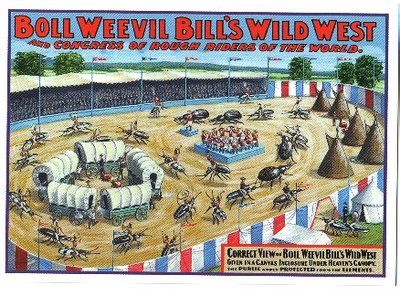 Some of you maybe don’t believe in this beetle, bug and bumblebee bonanza of bizarre: if so, we encourage you to discover more at http://www.insectscircus.co.uk/.
Some of you maybe don’t believe in this beetle, bug and bumblebee bonanza of bizarre: if so, we encourage you to discover more at http://www.insectscircus.co.uk/.This circus is also proudly member of the Insect Circus Society ( founded in 1933 by legendary impresario “Lord” George Piper).
Saturday, October 21, 2006
Forgotten Acts
THE OTARIS (2/2)
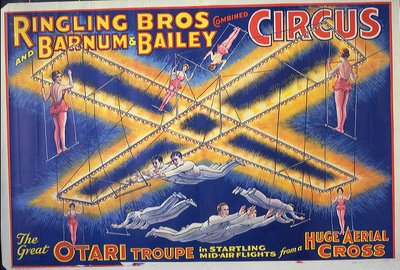
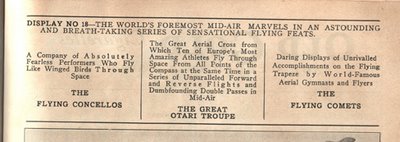

The Great Aerial Cross from Which Ten of Europe's Most Amazing Athletes Fly Through Space From All Points of the Compass at Same Time in a Series of Unparalleled Forward and Reverse Flights and Dumbfounding Double Passes in Mid-Air.
(quote from Ringling.Bros progam magazine, 1935)
In 1934, the Otaris crossed the Ocean to star with Ringling Bros. Barnum-Bailey.
In 1934, the Otaris crossed the Ocean to star with Ringling Bros. Barnum-Bailey.
For"Greatest Show on Earth" was the Gumpertz time, so I don’t know if they was previously booked by John Ringling in some of his European visits. The lavish litho reproduced above was engraved for them.
I scanned a page from the 1935 Ringling program to show what a display it was, with the Concellos in a side ring…Look:
I scanned a page from the 1935 Ringling program to show what a display it was, with the Concellos in a side ring…Look:

According the poster and the program, the Otaris act was mainly a matter of syncronized double passes. But what a sight…
I don’t know about them later.
In the 40’s, the “cross” flying trapeze act was used by the Croneras, and in the 50s by the large Togni family. Young Enis Togni used to be one of the flyers. In recent years, a similar combination was used by a Ringling troupe.
I don’t know about them later.
In the 40’s, the “cross” flying trapeze act was used by the Croneras, and in the 50s by the large Togni family. Young Enis Togni used to be one of the flyers. In recent years, a similar combination was used by a Ringling troupe.
The idea of white tail suits was few years ago back for the high wire act of the Guerreros in Monte Carlo.
Friday, October 20, 2006
The Surnateum

Scientific theatres, cabinets of curiosities, sideshows and theatrical magic have been gently stepping away of our world and lives, giving the place to the electronic fairs, web wonders, reality tv shows.
If Harry Houdini, Georges Meliés, Carl Hagenbeck or P.T.Barnum was alive today, where ever they would have look to satisfy their curiosity for the bizarre, or their primal need to discover and exploit a wonder-worker talent? They without a doubt would have paid a visit in Bruxelles to Christian Chelman and the place of which he is the keeper: Surnateum, The Museum of Supernatural History.
Along the years, I’ve regularly spent delightful hours in this ever-growing, unique and astonishing place, that is probably the world’s foremost collection of strange and
enchanted relics and artifacts.
Mr.Chelman is difficult to define. He is at the same time a Collector, Writer, Storyteller, Anthropologyst, Occultist, Archeologyst, Shaman, Hypnotist, Card Sharp, Teratologyst, Chryptozologist, Actor, Numerologyst, Ghost Hunter, Illusionist, Theologist, Mentalist, Inventor, Spiritualist, Taxydermist, Parapsycologist, Gymnopedian, Surrealist.
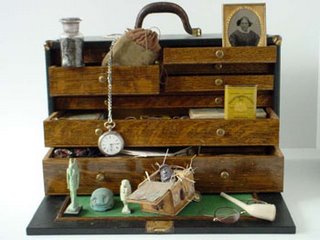
Surnateum hosts a range of bizarre items, and is specialized in hauntics (haunted antiquities): going from a hand of Yeti from Tibet to a vampire hunter kit; from ancient magician props to Egyptian papyrs for enchantment and spells, to the original photos of fairies signed by Arthur Conan Doyle. A human horned skull is not missing.
The concept behind all that, is a blend of seriuous collecting, literary surrealism (Breton, Cocteau), the tradition of mystery in arts, the genuine supernatural and, for non-believers, the respectable art of fraud.
What is more interesting, is that Mr.Chelman use parts of the collect
 ions for special interactive events, exhibitions or theatrical plays based on storytelling, conjuring, scientific demonstrations or supernatural powers. They are memorable experiences, between the modern theatrical purity of Peter Brook and the faded flavour of classic mystery novels or movies. Out of one of those performances, your vision of History is not anymore plain and linear as before.
ions for special interactive events, exhibitions or theatrical plays based on storytelling, conjuring, scientific demonstrations or supernatural powers. They are memorable experiences, between the modern theatrical purity of Peter Brook and the faded flavour of classic mystery novels or movies. Out of one of those performances, your vision of History is not anymore plain and linear as before.Surnateum is open only by special appointment. But the world has now a window on it: through its beautiful and enormous website. It is available both in English and French (this latter section is more complete). Don't miss it: www.surnateum.org
Wednesday, October 18, 2006
Forgotten great acts
THE FLYING OTARIS(1)

The novelty fever that always invaded circus and variety world affected acrobats in the strangest and most seductive ways.
Falling the curtain on the Codona legend, the art of flying trapeze in the mid-30’s is not remembered for remarkable stars, if we except the Concellos.
I’ve assembled some pictures of the german Otaris: I think that they likely are the originators of the “cross” trapeze act.
Yes, two trapeze bridges was presentes simultaneously.
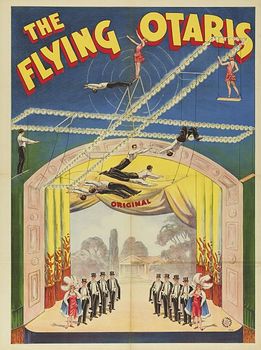
The Otaris was 10, of which two women.
But what was most impressive, is the elegance and modernity of their act.
We can deduce that they was wearing white silk tails and evening dresses, and their “bridge” was graced by hundreds of bulblights.
You can see this in th artist’s poster, a Friedlander litograph dating 1929.
In the following years, no wonder that they was starring for the most elegant circus of its times, Sarrasani: the two balck and white photographs shown here (above and down) are from a Sarrasani program of 1930.
Otaris were a star act, even if Sarrasani never promoted them of a personalized publicity. He in fact used to say: “I don’t book stars: Sarrasani is the star…”
In 1929 Sarrasani was the first circus ever in continental Europe to produce a winter show in a large hall, seating 12.000 (he was the first in many things).

The novelty fever that always invaded circus and variety world affected acrobats in the strangest and most seductive ways.
Falling the curtain on the Codona legend, the art of flying trapeze in the mid-30’s is not remembered for remarkable stars, if we except the Concellos.
I’ve assembled some pictures of the german Otaris: I think that they likely are the originators of the “cross” trapeze act.
Yes, two trapeze bridges was presentes simultaneously.

The Otaris was 10, of which two women.
But what was most impressive, is the elegance and modernity of their act.
We can deduce that they was wearing white silk tails and evening dresses, and their “bridge” was graced by hundreds of bulblights.
You can see this in th artist’s poster, a Friedlander litograph dating 1929.
In the following years, no wonder that they was starring for the most elegant circus of its times, Sarrasani: the two balck and white photographs shown here (above and down) are from a Sarrasani program of 1930.
Otaris were a star act, even if Sarrasani never promoted them of a personalized publicity. He in fact used to say: “I don’t book stars: Sarrasani is the star…”
In 1929 Sarrasani was the first circus ever in continental Europe to produce a winter show in a large hall, seating 12.000 (he was the first in many things).
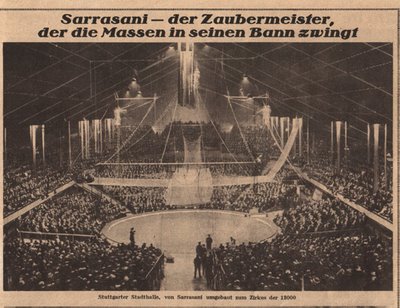 In the panoramic view of the hall, you can see the Otaris on their “bridges” and their cross-net.
In the panoramic view of the hall, you can see the Otaris on their “bridges” and their cross-net.
Then, in 1935, the Otaris left Europe crossing the Ocean...
Monday, October 16, 2006
Anomalies in portraits
“Freaks are born with their trauma. They already passed their test, in the life. They are aristocrats”.
Diane Arbus
Last Friday the first edition of Film Festival in Rome was opened by actress Nicole Kidman, introducing the world premiere of Fur, the film in wich she stars with Robert Downey jr. (director is Steven Shainberg).
Fur is an imaginary period in the life of photographer Diane Arbus (Kidman), daughter of a fur shop owner. This movie tells about her encounter in the 50s with a fictionary neighbor, Lionel Sweeney, whose body is covered of fur.
Arbus (1927-71), one of the master of American photography, was fasci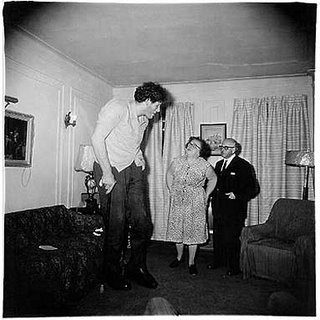 nated by human marginality and deformity: siamese twins, giants, albino fakirs, hermaphrodites, prostitutes, dwarves, amateur contorsionists in their backyards, burlesque dancers, mediocres masked balls of old peoples, small cafès aficionados or poor black families. Suburban slums, modest dressing rooms and cheap rural carnivals were the main subject of her art between 50s and 60s.
nated by human marginality and deformity: siamese twins, giants, albino fakirs, hermaphrodites, prostitutes, dwarves, amateur contorsionists in their backyards, burlesque dancers, mediocres masked balls of old peoples, small cafès aficionados or poor black families. Suburban slums, modest dressing rooms and cheap rural carnivals were the main subject of her art between 50s and 60s.
Her portraits of the “lady sword swallower” and the “giant jewish at home” (here shown) rests among the masterpieces of the photographic art. There are many lavish catalogues published, but try to get to see a live exhibition to really appreciate these pictures.
Now, the film producers didn’t got the permission to use the real pictures in the movie (so we are happily transgressing the law reproducing one here). For this reason, they probably invented the story of the furry friend. I suspect that his name, Lionel, can be inspired by the omonymous legendary “dog man” of museums and sideshows in the 20s.
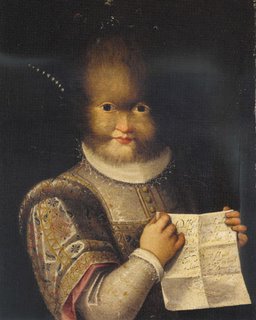
This pushes me to an erudite reference, Arbus not being the first woman in art to feed her inspiration with bodily anomalies as hipotrycosis (the excess of hair growht on the body).
In fact, italian court Renassaince painter Lavinia Fontana, left us this portrait of Antonietta Gonzales (circa 1594-5), establishing herself as a legitimateancestor of Arbus.
Antonietta, the dog-faced girl, was the daughter of a hairy man brought from Tenerife Island as a child to the court of France. Here he prospered, he went in Italy to the court of Mantua and agave birth to four children, one of them being Antonietta.
You can admire her portrait in France, in the castle museum of Blois (town that is also the hometown of Robert-Houdin). I appreciated the painting on exhibition in Italy few years ago, getting this souvenir postcard.
The movie, by the way, according to the critics doesn’t seems to make history. I will try to see it next week.
Diane Arbus
Last Friday the first edition of Film Festival in Rome was opened by actress Nicole Kidman, introducing the world premiere of Fur, the film in wich she stars with Robert Downey jr. (director is Steven Shainberg).
Fur is an imaginary period in the life of photographer Diane Arbus (Kidman), daughter of a fur shop owner. This movie tells about her encounter in the 50s with a fictionary neighbor, Lionel Sweeney, whose body is covered of fur.
Arbus (1927-71), one of the master of American photography, was fasci
 nated by human marginality and deformity: siamese twins, giants, albino fakirs, hermaphrodites, prostitutes, dwarves, amateur contorsionists in their backyards, burlesque dancers, mediocres masked balls of old peoples, small cafès aficionados or poor black families. Suburban slums, modest dressing rooms and cheap rural carnivals were the main subject of her art between 50s and 60s.
nated by human marginality and deformity: siamese twins, giants, albino fakirs, hermaphrodites, prostitutes, dwarves, amateur contorsionists in their backyards, burlesque dancers, mediocres masked balls of old peoples, small cafès aficionados or poor black families. Suburban slums, modest dressing rooms and cheap rural carnivals were the main subject of her art between 50s and 60s.Her portraits of the “lady sword swallower” and the “giant jewish at home” (here shown) rests among the masterpieces of the photographic art. There are many lavish catalogues published, but try to get to see a live exhibition to really appreciate these pictures.
Now, the film producers didn’t got the permission to use the real pictures in the movie (so we are happily transgressing the law reproducing one here). For this reason, they probably invented the story of the furry friend. I suspect that his name, Lionel, can be inspired by the omonymous legendary “dog man” of museums and sideshows in the 20s.

This pushes me to an erudite reference, Arbus not being the first woman in art to feed her inspiration with bodily anomalies as hipotrycosis (the excess of hair growht on the body).
In fact, italian court Renassaince painter Lavinia Fontana, left us this portrait of Antonietta Gonzales (circa 1594-5), establishing herself as a legitimateancestor of Arbus.
Antonietta, the dog-faced girl, was the daughter of a hairy man brought from Tenerife Island as a child to the court of France. Here he prospered, he went in Italy to the court of Mantua and agave birth to four children, one of them being Antonietta.
You can admire her portrait in France, in the castle museum of Blois (town that is also the hometown of Robert-Houdin). I appreciated the painting on exhibition in Italy few years ago, getting this souvenir postcard.
The movie, by the way, according to the critics doesn’t seems to make history. I will try to see it next week.
Saturday, October 14, 2006
Heinrich Lang
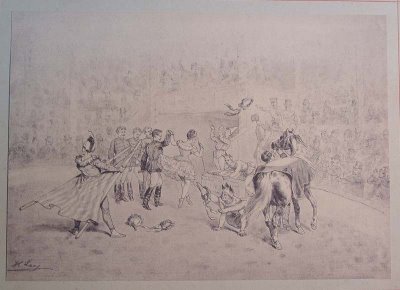
This is one of the many engraving of Heinrich Lang, a painter that around 1880 produced two wonderful album about equestrian german companies. I have most of them, so you will see more in the future.
If you click on it, you can enlarge and enjoy.
It is interesting to see how the concept of circus performances was different, with many peoples in the ring at once, in a true "company" spirit: as Gruss, Roncalli, Big Apple or Florilegio tried in modern times to rediscover.
About Enchantment and Wonder
"Magicians. They were true lords of the stage.
When the theatre was really theatre, able to enchant you with the pure theatricality".
This is a quote of Orson Welles I had forgot, and I found again today in some of my notes. He pronounced it on the opening sequence of his unfinished film, The Magic Show.
Look at this poster, his surreal, nonsensical beauty.
How deep is his promise of theatrical enchantment.
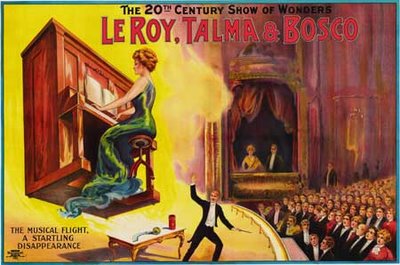
Now put yourself around 1910, walking on a street. And you see that around a corner.
You probably go to the local theatre and buy a ticket, to witness the "musical flight".
At this times, transmitting "wonder" was the main concern of artists and producers.
Where is that need of "enchant" gone today?
The point is not to be nostalgic, but to keep the intrinsecal potential of wonder of a performing arts.
Doesn't matter if the object is magic, dance, drama, circus or opera.
Maybe today theatre must regain some magic, and magic some theatricality.
When the theatre was really theatre, able to enchant you with the pure theatricality".
This is a quote of Orson Welles I had forgot, and I found again today in some of my notes. He pronounced it on the opening sequence of his unfinished film, The Magic Show.
Look at this poster, his surreal, nonsensical beauty.
How deep is his promise of theatrical enchantment.

Now put yourself around 1910, walking on a street. And you see that around a corner.
You probably go to the local theatre and buy a ticket, to witness the "musical flight".
At this times, transmitting "wonder" was the main concern of artists and producers.
Where is that need of "enchant" gone today?
The point is not to be nostalgic, but to keep the intrinsecal potential of wonder of a performing arts.
Doesn't matter if the object is magic, dance, drama, circus or opera.
Maybe today theatre must regain some magic, and magic some theatricality.
Sex, Drugs, and Making Circus Roll
Or, impressions on the literary genre of circus autobiography.
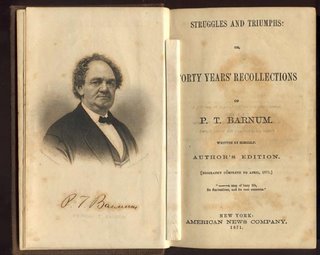
Autobiography is one of the primal literary forms. And one of his subcultural products, circus autobiography, turns to be a most entertaining literary form. Hundreds are been written, most of them even forgotten (for example, very few of us ever put eyes on a a copy of pamphlets such, say, The Chief Incidents of the non-professional and professional career of Holtum, the Dane surnamed The Cannon King. Related by himself, 1855). Reading them, we will never be able to separate the truth from facts concerning the whereabouts of authors being in their first occupation high wire walkers, whale exhibitors or flamboyant impresarios around the world in 80 years. But we just don’t care. We just ask them to absorbe us in adventures closer to Munchausen and Gulliver than to our usual order of things. From Althoff to Zavatta, Conklin to Van Amburgh, we just enjoy them. Otherwhise, for what reason Barnum’s literary effort was said to be the most read tome of his times after the Bible?
Once established the nobility of the genre, we are now happy to salute a new book in the perfect line of this tradition: Gerry Cottle’s Confessions of a Showman. Just fresh from press, I was surprised to discover it a couple of weeks ago on the main shelves of London’s best bookshops, so I treated myself with a copy (for those deprived by the pleasures of such a fisical encounter, Amazon.co.uk wil provide).
Cottle is a famous contemporary circus impresario. If considered in the proper contest (the British society and the circus international milieu 1970-90), his life and achievements have a quality not less interesting than precedessors, and illustrious waxers of themselfes, as Barnum or Sanger.
In circus history, the 70s are known for the rise of experimental circus. But in those same revolutionary years, the classic circus ind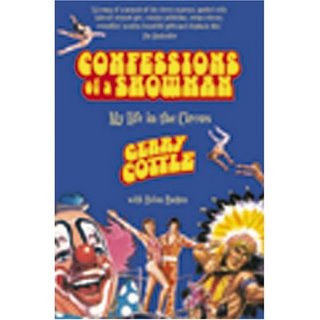 ustry knew a generation of unexpected kids from the “ordinary” society trying to revamp the traditional concept and the logic of the classic families, even without subvert their conservative aesthetics. They did that just opening their own big tops, doing brilliantly, and briefly reaching a leadership in the industry: as Siemoneit and of course Roncalli in Germany, Jean Richard in France, Castilla in Spain, the Felds, Binder and Vargas in the USA, etc. And Cottle in England.
ustry knew a generation of unexpected kids from the “ordinary” society trying to revamp the traditional concept and the logic of the classic families, even without subvert their conservative aesthetics. They did that just opening their own big tops, doing brilliantly, and briefly reaching a leadership in the industry: as Siemoneit and of course Roncalli in Germany, Jean Richard in France, Castilla in Spain, the Felds, Binder and Vargas in the USA, etc. And Cottle in England.
From one side, Cottle’s book follows all the necessary rules to be a classic in the genre: the “run away with the circus”, the humiliating education and the consequent acceptance in the world of saltimbanques, the following rags-to-riches adventures of becoming an established showman, the struggles and triumphs of such a mission, without disappointing the reader’s expectations of Far East trips, tamed lions and flamboyant press stunts.
From another side, there is more.
If the literary nature of impresarios autobiographies has the epic form of an almost superhuman hero taking his own feats seriously, Cottle turns upside down the concept: is he human. And he tells it with a lot of good self-humour. According the title, the winning key of the book is his form: a real confession more than a simple account.
It must be historical accepted that for a certain time Cottle was able to became, from nothing, the most powerful British circus man. If he tells us his story acknowledging his own talent, he is much more aware of all his weakness. And that is the the thing that makes the book great: as in the best of drama or literature, he invite us to identify in a normal human being. Ok, he tells us about enterprising feats of epic proportions (from risking money he doesn’t have to fly a complete circus to Iran few days before revolution), and he is more than proud of it. But his show is not Ringling or Roncalli, and he knows it. He is egocentric and megalomaniac in their same way, and he knows it. And he tells it to us with an irresistible sense of humour. God bless, finally, a circus impresario that for a time doesn’t take the circus seriously! And he finally breaks the law of “clean world for familes” with his intimate, frail, human, sometimes tragic but always passionate stories about sex and drugs, inestricables from his most serious vice and addiction: the showbiz itself.
What is also great, is the vision of the circus in its times. The honest and intelligent point of view of a man protective of a traditional vision, but at the same time able to investment ranging from a cheesy Circus on Ice to a hip Circus of Horrors, and so intelligent to recognize a genius like Pierrot Bidon as show director; fighting hard for the right to have animals but brave to attempt the first human circus. Foreseeing as fews the upcoming potential of Russian and Chinese shows. The book is written and produced for the general audience, and not for some obscure, celebrative press for fans. This opportunity is well played, showing in an entertainig way the nature of relationship between circus and society, his potential of interaction with the medias, his struggles with contemporary bureaucracies. And how deep is today the gap between the notion of traditional circus and the contemporary culture. And what is great of Cottle, is that as impresario he didn’had the professional tools of seven generations in his back, neither the intellectual education of the modern circus creators. He just did it, well aware the limits of both.
In one of the interviews for the launching of the book, he delivered a quote that impressed me:
"I think circus is at a terrible crossroads. Traditionalists have got to get out of their minds that animals aren't ever going to come back -- the majority of the public don't want them any more. And the new circuses are trying to impress each other, not audiences."

Autobiography is one of the primal literary forms. And one of his subcultural products, circus autobiography, turns to be a most entertaining literary form. Hundreds are been written, most of them even forgotten (for example, very few of us ever put eyes on a a copy of pamphlets such, say, The Chief Incidents of the non-professional and professional career of Holtum, the Dane surnamed The Cannon King. Related by himself, 1855). Reading them, we will never be able to separate the truth from facts concerning the whereabouts of authors being in their first occupation high wire walkers, whale exhibitors or flamboyant impresarios around the world in 80 years. But we just don’t care. We just ask them to absorbe us in adventures closer to Munchausen and Gulliver than to our usual order of things. From Althoff to Zavatta, Conklin to Van Amburgh, we just enjoy them. Otherwhise, for what reason Barnum’s literary effort was said to be the most read tome of his times after the Bible?
Once established the nobility of the genre, we are now happy to salute a new book in the perfect line of this tradition: Gerry Cottle’s Confessions of a Showman. Just fresh from press, I was surprised to discover it a couple of weeks ago on the main shelves of London’s best bookshops, so I treated myself with a copy (for those deprived by the pleasures of such a fisical encounter, Amazon.co.uk wil provide).
Cottle is a famous contemporary circus impresario. If considered in the proper contest (the British society and the circus international milieu 1970-90), his life and achievements have a quality not less interesting than precedessors, and illustrious waxers of themselfes, as Barnum or Sanger.
In circus history, the 70s are known for the rise of experimental circus. But in those same revolutionary years, the classic circus ind
 ustry knew a generation of unexpected kids from the “ordinary” society trying to revamp the traditional concept and the logic of the classic families, even without subvert their conservative aesthetics. They did that just opening their own big tops, doing brilliantly, and briefly reaching a leadership in the industry: as Siemoneit and of course Roncalli in Germany, Jean Richard in France, Castilla in Spain, the Felds, Binder and Vargas in the USA, etc. And Cottle in England.
ustry knew a generation of unexpected kids from the “ordinary” society trying to revamp the traditional concept and the logic of the classic families, even without subvert their conservative aesthetics. They did that just opening their own big tops, doing brilliantly, and briefly reaching a leadership in the industry: as Siemoneit and of course Roncalli in Germany, Jean Richard in France, Castilla in Spain, the Felds, Binder and Vargas in the USA, etc. And Cottle in England.From one side, Cottle’s book follows all the necessary rules to be a classic in the genre: the “run away with the circus”, the humiliating education and the consequent acceptance in the world of saltimbanques, the following rags-to-riches adventures of becoming an established showman, the struggles and triumphs of such a mission, without disappointing the reader’s expectations of Far East trips, tamed lions and flamboyant press stunts.
From another side, there is more.
If the literary nature of impresarios autobiographies has the epic form of an almost superhuman hero taking his own feats seriously, Cottle turns upside down the concept: is he human. And he tells it with a lot of good self-humour. According the title, the winning key of the book is his form: a real confession more than a simple account.
It must be historical accepted that for a certain time Cottle was able to became, from nothing, the most powerful British circus man. If he tells us his story acknowledging his own talent, he is much more aware of all his weakness. And that is the the thing that makes the book great: as in the best of drama or literature, he invite us to identify in a normal human being. Ok, he tells us about enterprising feats of epic proportions (from risking money he doesn’t have to fly a complete circus to Iran few days before revolution), and he is more than proud of it. But his show is not Ringling or Roncalli, and he knows it. He is egocentric and megalomaniac in their same way, and he knows it. And he tells it to us with an irresistible sense of humour. God bless, finally, a circus impresario that for a time doesn’t take the circus seriously! And he finally breaks the law of “clean world for familes” with his intimate, frail, human, sometimes tragic but always passionate stories about sex and drugs, inestricables from his most serious vice and addiction: the showbiz itself.
What is also great, is the vision of the circus in its times. The honest and intelligent point of view of a man protective of a traditional vision, but at the same time able to investment ranging from a cheesy Circus on Ice to a hip Circus of Horrors, and so intelligent to recognize a genius like Pierrot Bidon as show director; fighting hard for the right to have animals but brave to attempt the first human circus. Foreseeing as fews the upcoming potential of Russian and Chinese shows. The book is written and produced for the general audience, and not for some obscure, celebrative press for fans. This opportunity is well played, showing in an entertainig way the nature of relationship between circus and society, his potential of interaction with the medias, his struggles with contemporary bureaucracies. And how deep is today the gap between the notion of traditional circus and the contemporary culture. And what is great of Cottle, is that as impresario he didn’had the professional tools of seven generations in his back, neither the intellectual education of the modern circus creators. He just did it, well aware the limits of both.
In one of the interviews for the launching of the book, he delivered a quote that impressed me:
"I think circus is at a terrible crossroads. Traditionalists have got to get out of their minds that animals aren't ever going to come back -- the majority of the public don't want them any more. And the new circuses are trying to impress each other, not audiences."
Bye Bye Blackbird

A circus movie was on world premiere in France last Wednesday.
It is Bye Bye Blackbird, directed by Robinson Savary ((at his first long feature) and starring James Thierrée. Maybe those names says something to you? Well, the director is son of Jerome, the founder of "Grand Magic Circus", and the star actor is the son of Jean-Baptiste, the founder of "Cirque Imaginaire".
I was invited to see the movie in a preview one year ago, when Robinson was showing it in some festivals around the world (and winning awards) in the attempt to find a market.
The film is stunningly beautiful.
It has all the richness of the turn of the century circus imagery, without the romantic stereotypes, with a fascinating and surreal dark side. The story is captivating and surprising.
The creative team is of the best class, including designers having worked with Terry Gilliams and other greats.
We will be back on this subject in the next days.
James (the grandson of Charlie Chaplin) created also an impressive aerial coreography, and is remarkable in the star role, and other great actors in the movie are Michael Londsdale and Derek Jacobi.
We hope the best success for the movie on the French screens.
Don't miss the magnificent website: www
 .byebyeblackbird.com
.byebyeblackbird.com
Friday, October 13, 2006
About this Blog

This is a multilingual blog focusing mainly on the circus: its contemporary values, and the sense of his history, for the joy of the curious.
Between bizarre forgotten memories and peculiar daily facts, we attempts here to investigate the ambivalence of the circus today: the sad decadence of a noble past and the exciting vitality of his present.
The blog touches allied topics, possibly as anachronistics as the circus (magic, stage, monster of nature, obscure comedians, unlikely pastimes and whatever we desire). It hosts selected contributors, and is written in different languages: it can turn that some articles will be written in italian, other in French etc.
We try to do this without preconceived ideas and, most important of all, to have as much fun as possible…
Subscribe to:
Comments (Atom)
